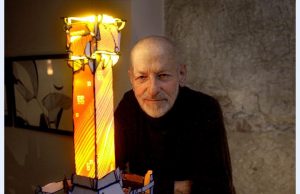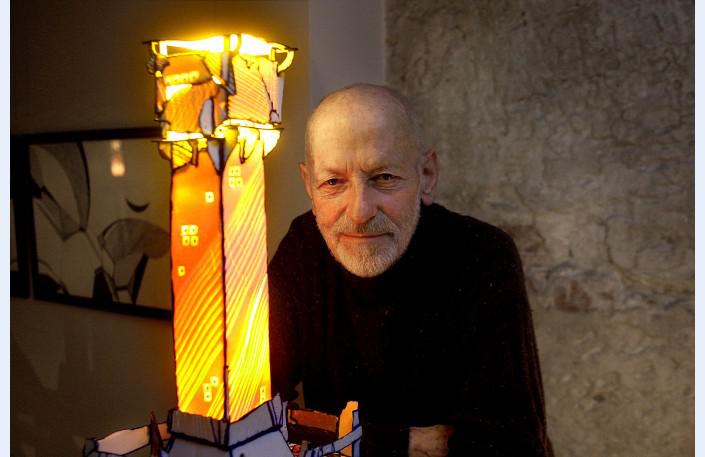Ceramist, architect (1931-2013). Peteris Martinsons was born on January 28, 1931 in Daugavpils in a family of servants. He lived in Daugavpils for the first 13 years of his life until during the time of the Second World War the family house of Martinsons was bombarded. The family loses all their belonging and is forced to move for a life to Smiltene, later on – to Aluksne, where in 1950 Peteris graduated from the Aluksne State Gymnasium. From 1951 to 1957 Peteris Martinsons studied at the University of Latvia, in the Faculty of Engineering, in the Department of Architecture, getting the qualification of an architect.
After the graduation Peteris Martinsons worked in the scientific research laboratory as an engineering technologist (1957-1958), the Design Institute “Latgiprogorstroj” (1958-1962) as an architect. During this time his passion for mountain climbing begins. To be able to go hiking, he needed a long summer holiday, so Peteris Martinsons gladly accepted the invitation to become a teacher of Riga School of Applied Art, where he worked from 1962 to 1971. Visiting his colleagues – ceramists, he began to work with clay and in that way accidentally became the ceramist at the age of 32. First of all, he made bows from a piece of clay and created piece works: candlesticks, vases, plates, and later came figurative works – dream birds, horses and devils. Peteris Martinsons organized the first ceramic exhibition in 1964, and his innovative works of geometric forms caused excitement among Latvian ceramists, who mostly followed the ethnographic samples. Since 1965 the artist worked in the experimental ceramic workshop of the Latvian Art Fund in Ķipsala.
The creative work of Peteris Martinsons in the meaning of aesthetic concept is united, but diverse and ever-changing in respect of technical performance, form and themes. His ceramic compositions he makes from clay, clinker, porcelain or stone mass. As an architect functionalist aesthetics is close to P. Martinsons. The Scandinavian sense of the world, Japanese culture and traditions of ceramics are close to him. Constructive, technically stable nature is expressed mostly in his ceramic compositions – objects in the first half of the70s. In the basis of its form are geometric figures: cube, pyramid, sphere. In the second half of 70s, in the 80s and 90’s freely formed plastic form is mainly characterized for the creations of Martinsons. For the artistic image’s essential creating factor became masterly made drawing and painting, which covers both a surface of ware and a plastic body. His architectural works has got numerous awards in international exhibitions of ceramics – three gold medals and premiums in Faenza (Italy), rewards in Gdansk and Sopot (Poland).
The works P. Martinsons are exhibited in many international exhibitions of ceramics in Latvia, Lithuania, Estonia, Italy, France, Poland, Germany and the United States. His personal exhibitions happened in Latvia, Lithuania, Estonia, Russia, Ukraine, Finland, the USA, Hungary and Sweden.
Theater is very close to Peteris Martinsons. He created the scenography for several productions of Mara Kimele in the Valmiera Drama Theatre (1976 1979). As an actor he filmed in the director’s A. Freimanis film “The Boy” (“Puika”) and the film of V. Kairiss “The Dark Deer” (“Tumšie brieži”).
From 1989 to 2000 P. Martinsons taught in the Art Academy of Latvia, led the Department of Ceramics. In 1992 he got a Master’s Degree in Art.
In 1961 Peteris Martinsons joined the Union of Architects of Latvia, from 1968 he is a member of the Latvian Artists’ Union, but from 1971 – a member of the International Academy of Ceramics in Geneva (Switzerland).
Since 1989 Martinsons traveled a lot, participated in various events – both the western and eastern directions. As a guest lecturer and a director of a workshop he worked in a number of universities of the USA and ceramic centers, participated in Congress’s work of the International Academy of Ceramics and international creative conferences in Spain, Wales, Lithuania, Poland, Turkey, Hungary and Slovenia.
The works of P. Martinsons are in property of several Latvian, foreign museums and galleries: the Latvian Art Fund, Museum of Applied Art in Riga, Russian Art Fund, Ariana Museum in Switzerland, private collection in Japan.
Even during the Soviet period Peteris Martinsons was awarded the medal “For labor heroism” (“Par darba varonību”) (1987), was awarded the Latvian SSR Honorary Title of Art Worker (1988). The Government of Latvia in 2001 evaluated the contribution of the artist with the highest award – the Order of the Three Stars, the 4th degree. In 2000 the ceramist was awarded the SCCF Lifetime Grant.
The permanent exhibition of P. Martinsons’s works was opened in Daugavpils Mark Rothko Art Center in 2013.
He died on August 2, 2013 in Riga.
Connection with Daugavpils: he was born in Daugavpils.



